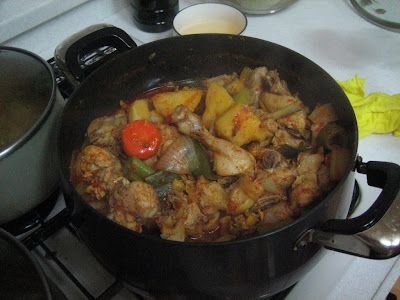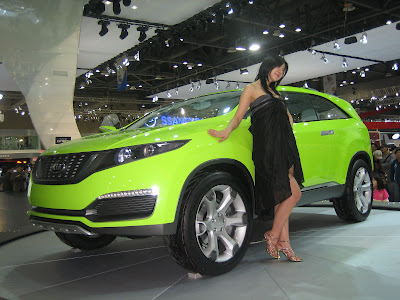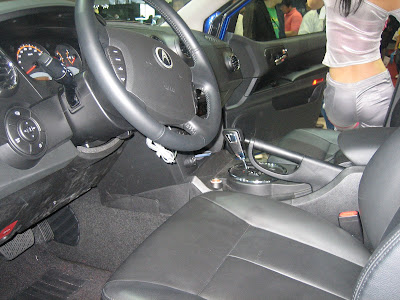 A distant second, the most popular traditional Korean chicken dish is samgyetang, a whole chicken stuffed with sticky rice, jujubes, gingko, and ginseng.
A distant second, the most popular traditional Korean chicken dish is samgyetang, a whole chicken stuffed with sticky rice, jujubes, gingko, and ginseng. Samgyetang (literally 'chicken and ginseng soup') is the number one traditional Korean chicken dish, but it doesn't seem to be eaten all that often by the average Korean. That said, it is exceedingly delicious and said to have tremendous health benefits, none of which I believe in.
Samgyetang (literally 'chicken and ginseng soup') is the number one traditional Korean chicken dish, but it doesn't seem to be eaten all that often by the average Korean. That said, it is exceedingly delicious and said to have tremendous health benefits, none of which I believe in.There's also jjimdak (steamed chicken),
Dakgalbi ('chicken ribs') is a pan-fried mix of boneless chicken, rice cake (ddeok), cabbage, red pepper paste, and other vegetables.
 A personal favorite, dakgalbi is not really an option for home cooking and is best enjoyed with a cold beer in a hot restaurant.
A personal favorite, dakgalbi is not really an option for home cooking and is best enjoyed with a cold beer in a hot restaurant.Then there's buldak ('fire chicken')
 As I have said many times before, Koreans tend to turn a lot of things that others regard as enjoyable into opportunities for group bonding through shared suffering. That includes Korean comedy as well as Korean food. Buldak is boneless chicken repeatedly basted with red pepper paste and grilled over an open fire. The successive layers of hot sauce render the chicken all but impossible to eat. Buldak exploded as a fad in 2005, starting in the downtown hotspots of Seoul. it quickly spread to the four corners of the country, and now those restaurants are mostly either closed or in the middle of a long painful decline. As a fad, buldak was similar to jjimdak, in that it took everyone by storm and couldn't keep up the momentum to become a fixture. I personally hate buldak, because it divorces food from everything enjoyable about eating, and gives you the spiciest trip to the John you've ever had the next day. Don't eat it.
As I have said many times before, Koreans tend to turn a lot of things that others regard as enjoyable into opportunities for group bonding through shared suffering. That includes Korean comedy as well as Korean food. Buldak is boneless chicken repeatedly basted with red pepper paste and grilled over an open fire. The successive layers of hot sauce render the chicken all but impossible to eat. Buldak exploded as a fad in 2005, starting in the downtown hotspots of Seoul. it quickly spread to the four corners of the country, and now those restaurants are mostly either closed or in the middle of a long painful decline. As a fad, buldak was similar to jjimdak, in that it took everyone by storm and couldn't keep up the momentum to become a fixture. I personally hate buldak, because it divorces food from everything enjoyable about eating, and gives you the spiciest trip to the John you've ever had the next day. Don't eat it.Last but not least is dakdoritang. The reason I call dakdoritang Korea's answer to freedom fries is because of a dispute involving the name of the food. As you may have figured out by now, dak means ;chicken'. Tang means 'soup' or 'stew'. The offending morpheme is dori, which is actually the Japanese word tori, which means 'chicken'. So it literally means 'chicken chicken soup'. There are a lot of nationalists in Korea, and they don't like Japan, or the Japanese colonial period, or something about Japanese culture, depending on whom you talk to. These people, including the people who make television, don't like to see a Japanese word sticking its tongue out at them from the middle of their menu, so they rather thought-politically change the name from dakdoritang to dakbokkumtang (bokkum, pronounced as in "Poke'em? I hardly even know'em!") means 'pan-fried' or 'braised', so that would make dakbokkumtang 'braised chicken stew', which would be fine, except that not everyone braises the chicken, as you'll soon see. This linguistic revisionism even goes so far as to change every utterance of the word dakdoritang to dakbokkumtang in the closed captioning, even though the only people who say dakbokkumtang are young liberal nationalists.
And now, without further ado, here is my mother-in-law's recipe for dakdoritang, with my advice for how to make it outside Korea.
Ingredients:
2 chickens
soy sauce
a lot of garlic
fresh ginger
carrots
potatoes
onions
sugar
black pepper
gochujang (red pepper paste)
1. Get two chickens at the market. Tell the chicken man that you're making dakdoritang and he'll cut it up approriately. Outside Korea I recommend buying chicken thighs, bone in and skin on, because that's where the flavor is.
2. Put the chicken in a pot full of water and bring it almost to a boil. Some schmaltz will appear on the top of the water.

3. Discard the water.

4. Your chicken should now look like this.

5. Add some soy sauce.

6. More soy sauce.

7. Add even more soy sauce. I reckon she poured in about 1/2 of a cup of soy sauce. At this point it's the only liquid in the pot so the chicken soaks it up.

8. Add red pepper powder. You'll notice that in the picture my mother-in-law is in fact adding red pepper paste. That is because she was not happy with the quality of the two kinds of red pepper paste currently in the house. I suggest that if you are making this outside Korea this wil cut down on expenses, in that you too can use red pepper paste twice instead of buying paste and powder. A heaping wooden spoonful will do. Incidentally, my mother-in-law has thrown her weight behind Haechandle brand gochujang (red pepper paste).

9. Add water. My mother-in-law said she added extra water because I like the sauce, but you can leave it up to taste, adding between 1/2 cup and a cup.

10. Add potatoes, cut roughly as for stew.

11. Add black pepper to taste.

11. Add sugar. I would guess about four tablespoons.

12. This much.

13. Stir and taste.

14. This is where you would normally add the red pepper paste. Again, Haechandle, and about a heaping wooden spoonful.

15. Chop and smash about 8 cloves of garlic.

16. Chop and smash one chunk of fresh peeled ginger. Ginger is the Korean's go-to odor eliminator, and I don't know if dakdoritang usually contains it, but, in an interesting side note, my mother-in-law hates chicken. She never ever eats it, since she was a child and she witnessed a particularly gruesome chicken beheading.

17. Add the garlic and ginger. By now the stew should look like this.

18. Add onions, cut large like the potatoes.

19. Add green onions, again cut roughly into one inch pieces.

20. I reminded my mother-in-law at the last minute that I like carrots, so she added half a carrot to appease me.

20. Cover and let it cook for about 10 minutes and it's good to go.

21. My mother-in-law is a natural showman and insisted that I take this more beautiful and well presented photo of the finished product. I am sure you'll agree she was right.

22. Serve with rice, kimchi, cucumbers, ssamjang, or whatever you want. Serves four.
























































